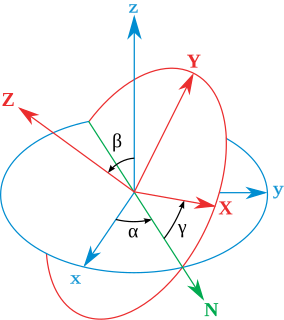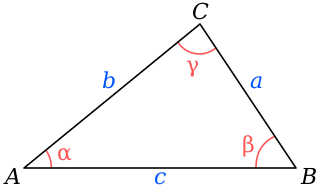Force balance and the steady flight equations
The forces acting on an aircraft in flight are the weight, aerodynamic force, and thrust. The weight is easiest to express in the Earth frame, where it has magnitude W and is in the +zE direction, towards the center of the Earth. The weight is assumed to be constant over time and constant with altitude.
Expressing the aerodynamic force in the wind frame, it has a drag component with magnitude D opposite the velocity vector in the −xw direction, a side force component with magnitude C in the +yw direction, and a lift component with magnitude L in the −zw direction.
In general, the thrust can have components along each body frame axis. For fixed wing aircraft with engines or propellers fixed relative to the fuselage, thrust is usually closely aligned with the +xb direction. Other types of aircraft, such as rockets and airplanes that use thrust vectoring, can have significant components of thrust along the other body frame axes. In this article, aircraft are assumed to have thrust with magnitude T and fixed direction +xb.
Steady flight is defined as flight where the aircraft's linear and angular velocity vectors are constant in a body-fixed reference frame such as the body frame or wind frame. In the Earth frame, the velocity may not be constant since the airplane may be turning, in which case the airplane has a centripetal acceleration  in the xE-yE plane, where
in the xE-yE plane, where  is the magnitude of the true airspeed and
is the magnitude of the true airspeed and  is the turn radius.
is the turn radius.
This equilibrium can be expressed along a variety of axes in a variety of reference frames. The traditional steady flight equations derive from expressing this force balance along three axes: the xw-axis, the radial direction of the aircraft's turn in the xE-yE plane, and the axis perpendicular to xw in the xw-zE plane,



where g is the standard acceleration due to gravity.
These equations can be simplified with several assumptions that are typical of simple, fixed-wing flight. First, assume that the sideslip β is zero, or coordinated flight. Second, assume the side force C is zero. Third, assume that the angle of attack α is small enough that cos(α)≈1 and sin(α)≈α, which is typical since airplanes stall at high angles of attack. Similarly, assume that the flight-path angle γ is small enough that cos(γ)≈1 and sin(γ)≈γ, or equivalently that climbs and descents are at small angles relative to horizontal. Finally, assume that thrust is much smaller than lift, T≪L. Under these assumptions, the equations above simplify to



These equations show that the thrust must be sufficiently large to cancel drag and the longitudinal component of weight. They also show that the lift must be sufficiently large to support the aircraft weight and accelerate the aircraft through turns.
Dividing the second equation by the third equation and solving for R shows that the turn radius can be written in terms of the true airspeed and the bank angle,

The constant angular velocity in the body frame leads to a balance of moments, as well. Most notably, the pitching moment being zero puts a constraint on the longitudinal motion of the aircraft that can be used to determine the elevator control input.
Force balance in straight and level flight
In steady level longitudinal flight, also known as straight and level flight, the aircraft holds a constant heading, airspeed, and altitude. In this case, the flight-path angle γ = 0, the bank angle μ = 0, and the turn radius becomes infinitely large since the airplane is not turning. For steady level longitudinal flight, the steady flight equations simplify to


So, in this particular steady flight maneuver thrust counterbalances drag while lift supports the aircraft's weight. This force balance is pictured in the graphic at the beginning of the article.

























